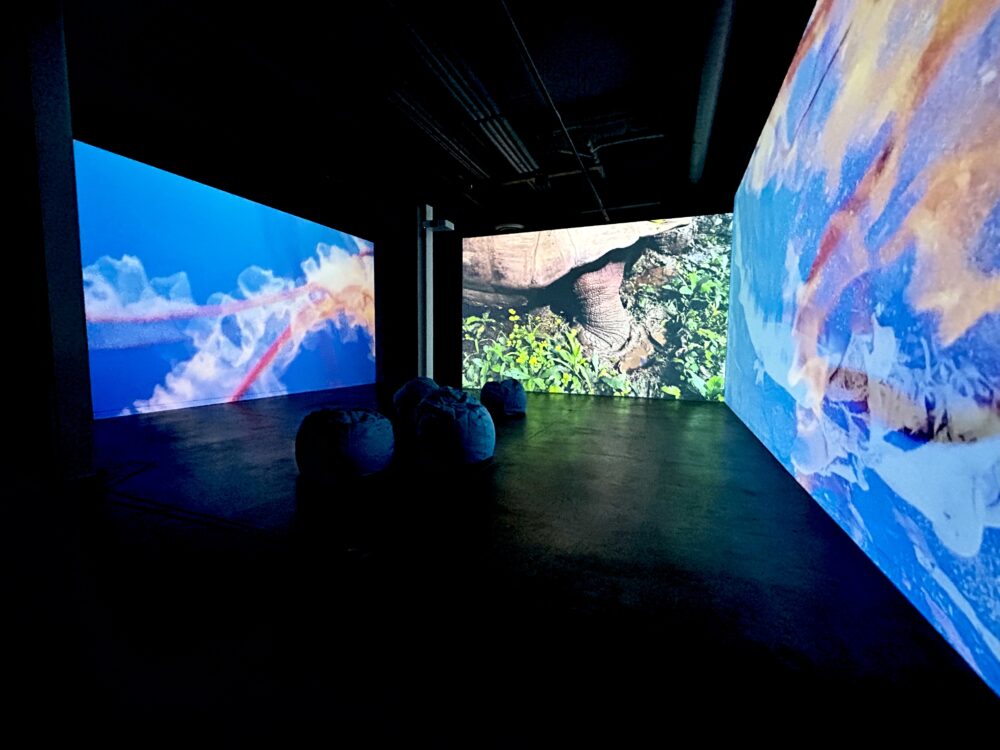Julia Edith Rigby: Fever Dream

June 1 – August 11, 2024
Fever Dream explores resonance, metamorphosis, multispecies relationships, and entanglements among organisms, oceanscapes, and sound.
Sourcing field recordings from sea caves, atmospheric river events, decomposing trees, aquaria, animals, and climatic phenomena, the opera expands our human-centered understanding of perception / world-making to consider the sensory worlds of more-than-humans. Wild bats and beetles, sea lion pups and tortoises, coyotes and hagfish, cicadas and cormorants, marine isopods and bees are among the many animals voicing the score.
Metamorphoses abound. Tree frogs transmogrify into brass bugles, pupae into pipe organ pistons. Sea caves and juniper trees transform into cellos.
The project experiments with expanding our senses of perception to consider different understandings of time, sounding and sensing. When we hear the glassy bells of starfish tube feet, we are hearing feet walking, tasting, and smelling all at once. Recordings of echolocating bats open our ears to means of sensing via pulse and echo. Buzzing cicadas reveal a world of sounding reliant on tympanal vibration and abdominal resonance.
Field recordings of animal vocalizations are arranged with recordings of local sea caves. Bowing wires that have been stretched across cave mouths allows us to hear a cave’s range of resonance, its unique acoustical architecture.
An ancient juniper tree also plays into the score. Copper wires stretched across a fire-carved scar in a 1000+ year old juniper are activated with a cello bow, with the tree itself acting as the resonant body for the wires’ vibrations. When we hear the vibrations of these fibers, we are hearing the acoustical anatomy of a tree, the resonance of centuries of climatic phenomena acting upon an organism.
What are new ways of thinking about growth and decay, decomposition and re-composition—of a musical note, a juniper tree, a sea cave—on larger-than-human and even geological timescales? How might listening to growth and decay on larger-than-human timescales influence our thinking about phenomena?
Many of the sounds and visuals in Fever Dream were created with the sound sculpture Brass Tide, which can be viewed in the main gallery space. Sourcing material from traumatized instruments and brass objects salvaged from waste streams and flea markets, Rigby welded the piece in the Okada Sculpture and Ceramic Facility at the Bemis Center for Contemporary Arts in Omaha, Nebraska.
Pipe organ soundscapes and video footage from the performance Gill Valves are also present in this piece. Gill Valves was a community-activated performance in which audience members were invited to sit back-to-back with a pipe organ and experience sound on a seismic scale, to move freely and observe the ways our spatial movements shaped not just our perception of the soundscape but also the very nature and creation of that soundscape. A similar phenomenon is occurring here now, whereby your presence and movement in this space is shaping an ephemeral sonic signature. As you move through this space, what are your own relationships to sounding and listening, sensation and perception?
Rigby played the parts for pipe organ, piano and viola. Kafele Williams played the trumpet elements, and The Wrinkles in Time Brass Band played horns and percussion.
ABOUT THE ARTIST
Julia Edith Rigby is an Orange County-based experimental sound artist, composer, and sculptor who thinks about entanglements among humans and more-than-humans, phenomena, and sound. She works with found materials and found sites to explore phenomena, perception, and sense of place.
The artist has performed at LEAF Festival in Lafayette, Colorado (2024), LOW End in Omaha, Nebraska (2023), and the Atlantic Center for the Arts in New Smyrna, Florida (2023). She is a recipient of artist grants from the Center for Cultural Innovation and the U.S. Department of State’s Bureau of Educational and Cultural Affairs. She was recently awarded an artist residency at the Sitka Center for Art and Ecology in Oregon. Rigby was the Sound Art + Experimental Music Fellow at the Bemis Center for Contemporary Arts in Omaha, Nebraska in fall 2023. She has been an artist in residence at GlougauAIR Artist Residency in Berlin, PLAYA Summer Lake, Anderson Ranch Arts Center, Kala Art Institute, and others. She has exhibited work in San Francisco, Los Angeles, New York, and Berlin. Rigby received her MFA in Studio Art at the University of California, Davis (2020), where she was a recipient of the Mary Lou Osborn Award and the Fay Nelson Award.